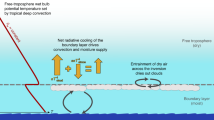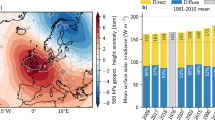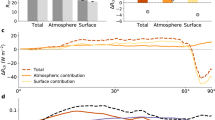Abstract
Arising from M. T. Rosing, D. K. Bird, N. H. Sleep & C. J. Bjerrum, Nature 464, 744–747 (2010)10.1038/nature08955
The Sun was fainter when the Earth was young, but the climate was generally at least as warm as today; this is known as the ‘faint young Sun paradox’. Rosing et al.1 claim that the paradox can be resolved by making the early Earth’s clouds and surface less reflective. We show that, even with the strongest plausible assumptions, reducing cloud and surface albedos falls short by a factor of two of resolving the paradox. A temperate Archean climate cannot be reconciled with the low level of CO2 suggested by Rosing et al.1; a stronger greenhouse effect is needed.
Similar content being viewed by others
Main
During the Archean eon, the Earth received 76% to 83% of the energy from the Sun that it does today. If the Earth’s greenhouse effect and albedo were the same as now, the Earth would have been in continual deep freeze until one billion years ago, with glaciers reaching the Equator. However, Archean glacial sediments are rare and geological evidence indicates that the Archean was typically warmer than today (we are in a glacial period now). With the amount of energy reaching the Earth given by F = ¼S0(1 − α) = 239 W m−2 (using the present-day solar constant S0 = 1,368 and albedo α = 0.3), the radiative deficit in the Archean would have been (1–0.79)F ≈ 50 W m−2. Resolution of the ‘faint young Sun paradox’ requires a positive radiative forcing—from reducing the albedo or increasing the greenhouse effect—of more than 50 W m−2.
Clouds have two competing radiative effects: they reflect sunlight but they also add to the greenhouse effect if they are colder than the surface. Reflection dominates in low clouds, and the greenhouse effect dominates in high clouds. Therefore the absolute upper bound on warming by decreasing cloud reflectivity would be found by removing low clouds entirely. This gives a forcing of 25 W m−2, half of what is needed to resolve the ‘faint young Sun paradox’ (our cloud model is described in the Methods). Any reduction to high clouds would cause a cooling.
Rosing et al.1 justify less-reflective clouds with the incorrect statements that most cloud condensation nuclei (CCN) are from biogenic dimethyl sulphide (DMS), and that DMS is solely produced by eukaryotes. DMS is also produced microbially2. Products of DMS contribute only 3% of Northern Hemisphere CCN and 10% of Southern Hemisphere CCN today3. Other biological4 and non-biological sources, especially sea salt, provide CCN. If CCN production were to depend only on eukaryotic DMS emissions1, we would expect to see significant cooling when eukaryotes evolved, but no such cooling is evident.
Nevertheless, we can assume no biological CCN supply and quantify the resulting forcing. Over the modern ocean the effective radius re of cloud drops rarely exceeds 15 µm (ref. 5) even in remote and unproductive regions (the re of 17 µm to 30 µm used by Rosing et al.1 is too high). For an upper bound, we increase low cloud droplet size by 50% from our standard case, from 11 µm to 16.5 µm. With no change in cloud thickness, the forcing is 7 W m−2. Clouds with larger drops may rain out faster. Parameterizations of enhanced rain-out vary from proportional to (re,0/re)1 to proportional to (re,0/re)5.37 (refs 6 and 7); the corresponding extra forcing would be 4–15 W m−2 (remote sensing data for marine stratus suggest that the low end of this range is more appropriate8). The sum is 11 W m−2 to 22 W m−2, with the low end being most likely.
The authoritative estimate of the global energy budget9 gives global mean and ocean albedos of 0.125 and 0.090 respectively. The largest realistic surface darkening is from the present mean to an all-ocean world, which gives a radiative forcing of 5 W m−2.
Increasing the CO2 mixing ratio to 1,000 parts per million by volume (p.p.m.v.; the upper bound according to Rosing et al.1) gives a forcing of 6 W m−2. Rosing et al.1 rely on 1,000 p.p.m.v. CH4 for much of their warming, ignoring relevant atmospheric chemistry. As the partial pressure of CH4 ( ) approaches that of CO2 (
) approaches that of CO2 ( ), hydrocarbon haze forms in the stratosphere, the cooling effect of which outweighs the greenhouse effect of CO2 and CH4 (refs 10 and 11). Numerical models12 predict haze production when
), hydrocarbon haze forms in the stratosphere, the cooling effect of which outweighs the greenhouse effect of CO2 and CH4 (refs 10 and 11). Numerical models12 predict haze production when  /
/ = 0.1 and haze production has been seen in laboratory experiments13 where
= 0.1 and haze production has been seen in laboratory experiments13 where  /
/ = 0.3. With 1,000 p.p.m.v. CO2, the maximum CH4 concentration that can give warming is 300 p.p.m.v., which would contribute 7 W m−2 of additional forcing.
= 0.3. With 1,000 p.p.m.v. CO2, the maximum CH4 concentration that can give warming is 300 p.p.m.v., which would contribute 7 W m−2 of additional forcing.
Changes to clouds could in theory considerably reduce the amount of greenhouse gases required, because gaseous absorption depends on the logarithm of gas abundance. But even with the highly unlikely assumption of no biological CCN supply, cloud changes can provide only one-quarter to one-half of the required radiative forcing. Any changes to clouds would require strong justification, which Rosing et al.1 do not provide. A strong greenhouse effect is required in the Archean. The alternative is an extremely cold climate with continual mid- to low-latitude glaciation, for which there is no evidence.
Methods
We calculate the radiative forcing (change in net flux at the tropopause) on a single global annual mean atmospheric profile, with three layers of clouds that overlap randomly14. The radiative fluxes on eight sub-columns corresponding to each cloud combination are calculated with the RRTM model15. For our standard case, cloud water paths are [Whigh, Wmid, Wlow] = [20, 25, 40] g m−2, fractions are [fhigh, fmid, flow] = [0.25, 0.25, 0.40] and the surface albedo is 0.125. Standard low- and mid-level clouds are liquid with re = 11 µm and high clouds are ice with generalized effective size of Dge = 75 µm. For radiative forcings described in the text, the low cloud water path is varied but all other parameters are unchanged.
References
Rosing, M. T., Bird, D. K., Sleep, N. H. & Bjerrum, C. J. No climate paradox under the faint early Sun. Nature 464, 744–747 (2010)
Lin, Y. S., Heuer, V. B., Ferdelman, T. G. & Hinrichs, K.-U. Microbial conversion of inorganic carbon to dimethyl sulfide in anoxic lake sediment (Plußsee, Germany). Biogeosciences 7, 2433–2444 (2010)
Woodhouse, M. T. et al. Low sensitivity of cloud condensation nuclei to changes in the sea-air flux of dimethyl-sulphide. Atmos. Chem. Phys. 10, 7545–7559 (2010)
Leck, C. & Bigg, E. K. Source and evolution of the marine aerosol—a new perspective. Geophys. Res. Lett. 32 L19803 10.1029/2005GL023651 (2005)
Bréon, F. Tanré, D. & Generoso, S. Aerosol effect on cloud droplet size, monitored from satellite. Science 295, 834–838 (2002)
Kump, L. R. & Pollard, D. Amplification of Cretaceous warmth by biological cloud feedbacks. Science 320, 195 (2008)
Penner, J. E. et al. Model intercomparison of indirect aerosol effects. Atmos. Chem. Phys. 6, 3391–3405 (2006)
Kaufman, Y. J., Koren, I., Remer, L. A., Rosenfeld, D. & Rudich, Y. The effect of smoke, dust, and pollution aerosol on shallow cloud development over the Atlantic Ocean. Proc. Natl Acad. Sci. USA 102, 11207–11212 (2005)
Trenberth, K. E., Fasullo, J. T. & Kiehl, J. T. Earth’s global energy budget. Bull. Am. Meteorol. Soc. 90, 311–323 (2009)
McKay, C. P., Lorenz, R. D. & Lunine, J. I. Analytic solutions for the anti-greenhouse effect: Titan and the early Earth. Icarus 91, 93–100 (1991)
Haqq-Misra, J. D., Domagal-Goldman, S. D., Kasting, P. & Kasting, J. F. A revised, hazy methane greenhouse for the Archean Earth. Astrobiology 8, 1127–1137 (2008)
Domagal-Goldman, S. D., Kasting, J. F., Johnston, D. T. & Farquhar, J. Organic haze, glaciations and multiple sulfur isotopes in the Mid-Archean Era. Earth Planet. Sci. Lett. 269, 29–40 (2008)
Trainer, M. G. et al. Organic haze on Titan and the early Earth. Proc. Natl Acad. Sci. USA 103, 18035–18042 (2006)
Goldblatt, C. & Zahnle, K. J. Clouds and the faint young Sun paradox. Clim. Past 7, 203–220 (2011)
Clough, S. A. et al. Atmospheric radiative transfer modeling: a summary of the AER codes. J. Quant. Spectrosc. Radiat. Transf. 91, 233–244 (2005)
Author information
Authors and Affiliations
Contributions
C.G. and K.J.Z. discussed the article to which this note responds. C.G. performed all model runs and quantitative analysis. C.G. and K.J.Z. both contributed qualitative analysis and both contributed to writing the paper.
Corresponding author
Ethics declarations
Competing interests
Competing financial interests: declared none.
Rights and permissions
About this article
Cite this article
Goldblatt, C., Zahnle, K. Faint young Sun paradox remains. Nature 474, E1 (2011). https://doi.org/10.1038/nature09961
Received:
Accepted:
Published:
Issue Date:
DOI: https://doi.org/10.1038/nature09961
This article is cited by
-
Geological diversity and microbiological potential of lakes on Mars
Nature Astronomy (2022)
-
Is the Faint Young Sun Problem for Earth Solved?
Space Science Reviews (2020)
-
Mission to Planet Earth: The First Two Billion Years
Space Science Reviews (2020)
-
Origin and evolution of the atmospheres of early Venus, Earth and Mars
The Astronomy and Astrophysics Review (2018)
-
Biochemical characterization of predicted Precambrian RuBisCO
Nature Communications (2016)
Comments
By submitting a comment you agree to abide by our Terms and Community Guidelines. If you find something abusive or that does not comply with our terms or guidelines please flag it as inappropriate.



